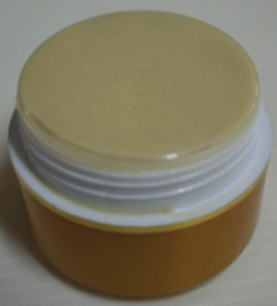Facial scrub cream contained ginger-enzyme
DOI:
https://doi.org/10.60136/bas.v1.2012.187Keywords:
Ginger protease, Scrub cream, Zingiber officinaleAbstract
This study was performed to develop facial scrub cream containing ginger enzyme. It was found that activity and specific activity of the crude ginger protease were 15 Units/ml/min and and 377 Units/mg protein, respectively. First, a crude preparation of ginger protease was lyophilized using a freeze dryer. Its stability was improved by mixing casein and borox and the protease powder. The specific activity value of the stabilized ginger protease was 1,025 Units/mg protein. The stabilized ginger protease was mixed with scrub cream. The mixture contain 20% (w/w) of the enzyme, equivalent to 9.9 Unit/ml/min. Then, the ginger enzyme scrub cream was tested on animals for primary irritant properties. No irritation was observed, as indicated by the primary irritation index of 0.6. In the efficiency study, the ginger enzyme scrub cream and control scrub cream were used by 20 healthy female for 14 days. There were no significant difference between the ginger enzyme scrub cream and the control scrub cream. Besides, dark spots on faces of certain volunteers who used the ginger enzyme scrub cream were dramatically decreased. The volunteers satisfaction on the quality, brightness, moisturizer, wrinkle and total satisfaction of the ginger enzyme scrub cream were evaluated by the questionnaires. The results showed that the volunteers were more satisfied with the ginger enzyme scrub cream than the control scrub cream, as shown by total satisfaction score of 90 and 64%, respectively.
References
ฐานข้อมูลสมุนไพร มหาวิทยาลัยมหิดล. [ออนไลน์] สามารถเข้าถึงได้จาก http://www.medplant.mahidol.ac.th/ pubhealth/zinoff.html. 2555, เข้าถึงข้อมูลวันที่ 9 เมษายน 2555.
Mascolo N, Jain R, Jain SC, Capasso F. Ethnopharmacologic investigation of ginger (Zingiber officinale). J Ethnopharmacol. 1989, 27(1/2):129-40.
Basavarajaiah CR, Lucas DS, Anadarajashekhar R, Parmesh RR. Fundamentals of ayurvedic pharmacetuicals: anti-inflammatory activity of different preparations of three medicinal plants. J. Res. Edu. Ind. Med. 1990, 9(3): 25-30.
Thompson, E. H., and Allen, C. E. Ginger rhizome: a new source of proteolytic enzyme. J. Food Sci. 1973, 38, 652-655.
Choi, K. H., Laursen, R. A. and Allen, K. N. The 2.1A Structure of a cysteine protease with proline specificity from ginger rhizome, Zingeber officinale. Biochem. 1999, 38, 11624-11633.
Ichikawa, Y., Sasa, H., and Michi, K. Purification of ginger protease. J. Jpn. Soc. Food Nutr. 1973, 26, 377-383.
Hashimoto, A., Takeuti, Y., Kawahara, Y., and Yasumoto, K. Proteinase and collagenase activities in ginger rhizome. J. Jpn. Soc. Nutr. Food Sci. 1991, 44, 127-132.
Su, H. P., Huang, M. J. and Wang, H. T. Characterization of ginger proteases and their potential as a rennin replacement J. Sci. Food. Agric. 2009, 89, 1178-1185.
นันทพร สุขกระจ่าง, การแปรรูปและการใช้ประโยชน์ของผลิตภัณฑ์ขิงผงที่มีกิจกรรมของเอนไซม์โปรติเอส. วิทยานิพนธ์วิทยาศาสตร์มหาบัณฑิต สาขาวิชาเทคโนโลยีอาหาร มหาวิทยาลัยสงขลานครินทร์ 2548.
US Patent 6,416,769 B1. Cosmetic compositions comprising exfoliating enzymes and uses thereof. Jacob Vromen, Inventor. 2002.
US patent 4,842,758. Stabilized enzyme system for use in aqueous liquid built detergent compositions. Andre Crutzen, inventor. 1989.
Kunitz, M. Crystalline soybean Trypsin Inhibitor, II. General properties. J. Gen. Physiology. 1947, 30, no. 4, 291-310.

Downloads
Published
How to Cite
Issue
Section
License
Copyright (c) 2012 Bulletin of Applied Sciences

This work is licensed under a Creative Commons Attribution-NonCommercial-NoDerivatives 4.0 International License.









